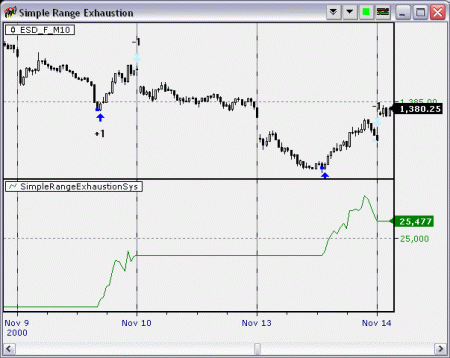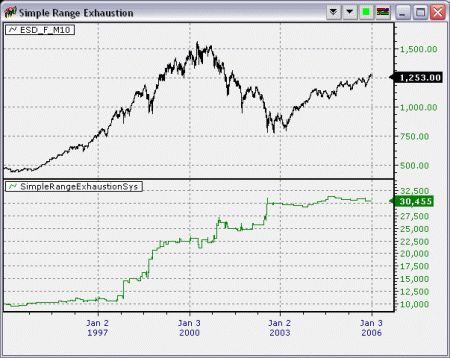Counter-Trend Trading with Simple Range Exhaustion System
Here is an extremely simple trading system that violates the classic rule of trading, trend is your friend, with very good results. It is an excellent example that illustrates how counter-trend approaches work.
Simple Range Exhaustion System
1. Calculate the daily 20 period average range.
2. Today’s range must expand to exceed #1.
3. The 2-day combined range must expand to exceed 2.2 times of #1.
4. Go long at market if the market is trading in the lower portion of the 2-day range.
5. Protective stop is placed at 0.35 times #1 from the entry price.
6. If not stopped out, exit by 16:00 Eastern Time. i.e. a day trading system
To understand what the system does, just think about a rubber band that stretched thin. Once the force that hold up the stretched rubber band is gone, the rubber band will snap back to its normal self. Similarly, when the market moves in a particular direction too fast too soon, it will then snap back to a more sustainable level.
Almost all counter-trend trading techniques are based on similar principle. As oppose to wait for a confirmation before taking a position like trend followers, most counter-trend traders will try to time their entries as close to the extreme reversal points as possible to maximize the profits and minimize the risk exposures.
The Chart
I applied the system onto Emini S&P 10-min data, covering only 9:30 to 16:00 Eastern Time. Commission of $2.50 per side per contract is taken into account.
Here is the indicator setup,
Here is how the system works,
Performance
The equity curve of the system covering 1997 until end of 2005,
Notice that the system performs equally well in both bullish years and bearish years, even though it is a long only system. This implies the system has real statistical bias.
The duration in market for this system is just 1%. That leaves a lot of room for integration with other trading systems with minimal interference.
There is a major weakness with this system – when there is no range to work with, then you cannot measure range exhaustion. Thats exactly what happened during year 2003 and 2005 where the system has almost no trade.
Complete Indicator
Simple Range Exhaustion System.
Summary
This trading system is a good starting point for further research in utilizing range expansion for counter-trend trading. I have even included an extra filter in the indicator that you can uncomment and then test out its effect. Enjoy!













what is the software name u used for backtesting ?
NeoTicker
my apologies, could you explain what a “a daily 20 period average range” is?
i know what a 20 day moving average here, not sure what’s the range mentioned here. thanks
range = high – low